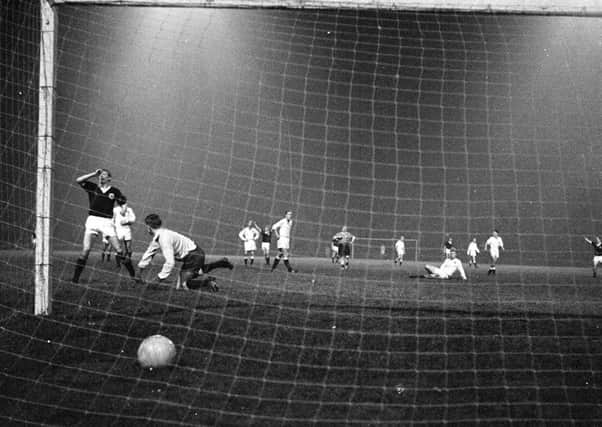Tom Peterkin: Europe's most dedicated football fans deserve more


Perhaps it’s a bit “wha’s like us?” to say so, especially given Scotland’s two-decade failure to qualify for a World Cup, but there can be few countries in the world with as proud a footballing tradition as ours.
England may have given the game to the world but it was Scotland who taught the world to play.
Advertisement
Hide AdAdvertisement
Hide AdIn the Victorian and Edwardian eras, it was Scottish footballers who perfected the passing game as an antidote to the ruder “kick and rush” tactics that marked the early days of the sport.
Scottish professionals exported their expertise to clubs south of the border while teams in Scotland were supported with passion bordering on infatuation and the national team became the outlet for unbridled patriotism.
In Scotland, football was a mass spectator sport, marked by high-levels of participation and which involved the common man and kings (with particular reference to Denis Law and Kenny Dalglish).
The game was embraced so feverishly that, by the early 20th century, Glasgow found itself with no fewer than three grounds with massive capacity – Ibrox, Celtic Park and Hampden.
By today’s standards the existence of three large capacity stadiums in one city may seem excessive – particularly when it is considered that it is the amateurs of Queen’s Park who have been rattling around in an empty Hampden on a Saturday afternoon.
But the very existence of these three stadiums (and Queen’s Park – founded 1867) is a proud legacy that reflects Scotland’s historical obsession with the beautiful game.
Until this week, a major part of that footballing legacy and its proud traditions were under threat from a proposal to move the home of Scottish football from Hampden to Murrayfield.
It can’t just have been the rugger-types living in the handsome villas of Ravelston and Murrayfield who breathed a sigh of relief when it was announced that the national football stadium would remain in Glasgow.
Advertisement
Hide AdAdvertisement
Hide AdThere may have been sound pragmatic reasons for playing the round ball game at BT Murrayfield, but those with a romantic attachment to Scotland’s proud footballing history must be glad that Hampden will be spared obscurity and demolition.
It was noticeable that the two Scottish philanthropists who have come to Hampden’s rescue both have a strong sense of Scottish football tradition and its roots in Scotland’s biggest city.
The decision by Sir Tom Hunter and Lord Haughey to donate £1.25 million each to keep Scotland’s national team at Hampden shows respect of footballing heritage.
In Lord Haughey’s case, his affinity for Hampden goes back to his teenage years when he represented Queen’s Park at under-16 and under-17 level.
Glasgow has been the crucible of Scottish football, whatever supporters of Hearts, Hibs, Dundee, Dundee United and Aberdeen may say.
Not all aspects of the Celtic/Rangers Old Firm rivalry are healthy, but it is at least a product of a fanatical enthusiasm for the game which must be harnessed for the sake of its future.
Scotland may have plenty going for itself when it comes illustrious football history, but recent performances on the park are another matter entirely. The national team is a pale shadow of the gifted, but ultimately flawed, outfits which qualified for World Cups as a matter of routine.
Celtic’s European Cup triumph took place more than 50 years ago. Successful European incursions by Rangers and Aberdeen feel like ancient history.
Advertisement
Hide AdAdvertisement
Hide AdGone are the days when crowds of more than 100,000 produced their intimidating “Hampden Roar”. The “revamped” stadium with its poor views of the pitch has come in for justified criticism.
Ever since the Hampden/Murrayfield arguments began being aired, there have been many voices bemoaning the lack of atmosphere at Hampden.
It sounds rather trite to say so, but the design of stadiums has little to do with their atmosphere when compared to activities on the park. Surely the only way to recapture the Hampden Roar is for a marked improvement in performances.
It is bitterly disappointing that there are young adults in Scotland who have never known the carnival of Scotland playing in the World Cup.
For too long the football-loving Scottish public has been starved of success.
On the positive side, there would still appear to be an enormous appetite for the game in this country, despite declining attendances and participation levels.
At the beginning of this year, a European study suggested that attendances at Scotland’s top-flight matches are the highest in Europe when the country’s population is taken into account.
The European Professional Football League’s (EPFL) second Fan Attendance Report found that the average of 11,436 fans who turned up to Scottish top-flight matches over the last seven seasons represented 0.21 per cent of the population.
Advertisement
Hide AdAdvertisement
Hide AdThat beat the 0.14 per cent who attended equivalent matches in Switzerland and Norway, the 0.12 per cent in Denmark and the 0.07 per cent attending England’s Premier League. Despite everything, Scotland is still fitba’ crazy. We just need the results. It is difficult to imagine how moving international football out of its traditional heartland and scene of past glories to the citadel of Scottish rugby would have helped those.
